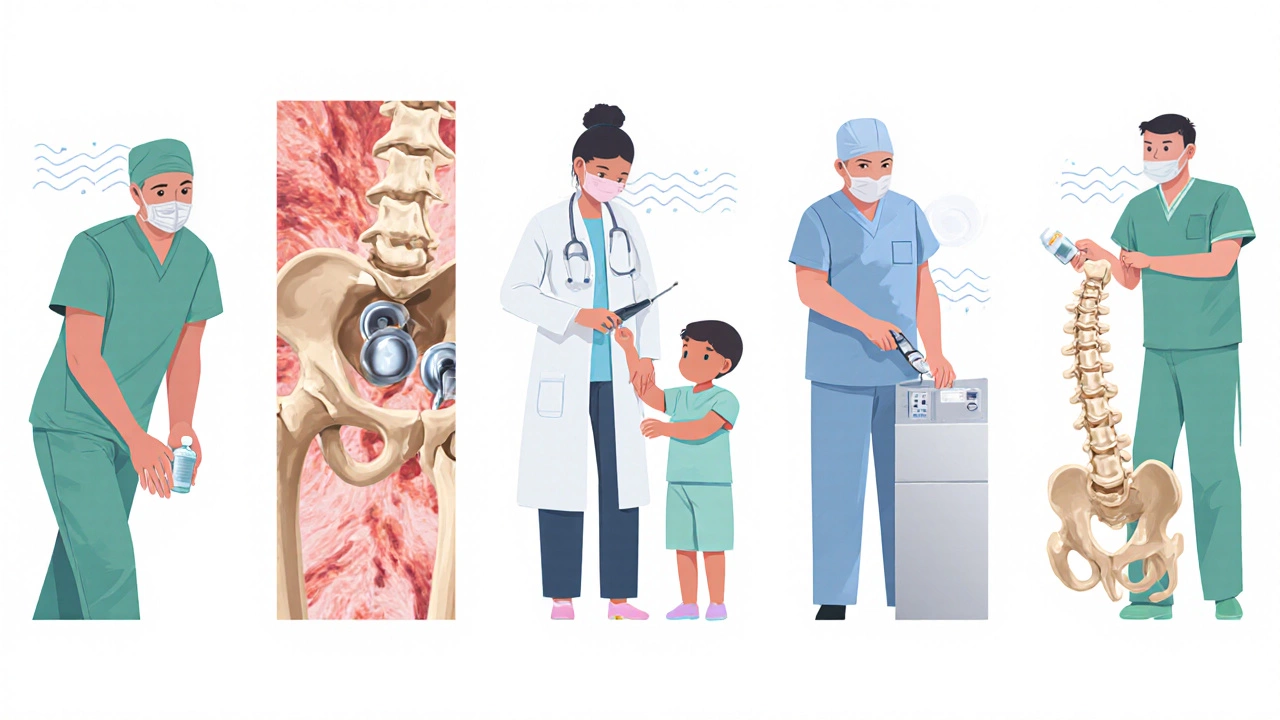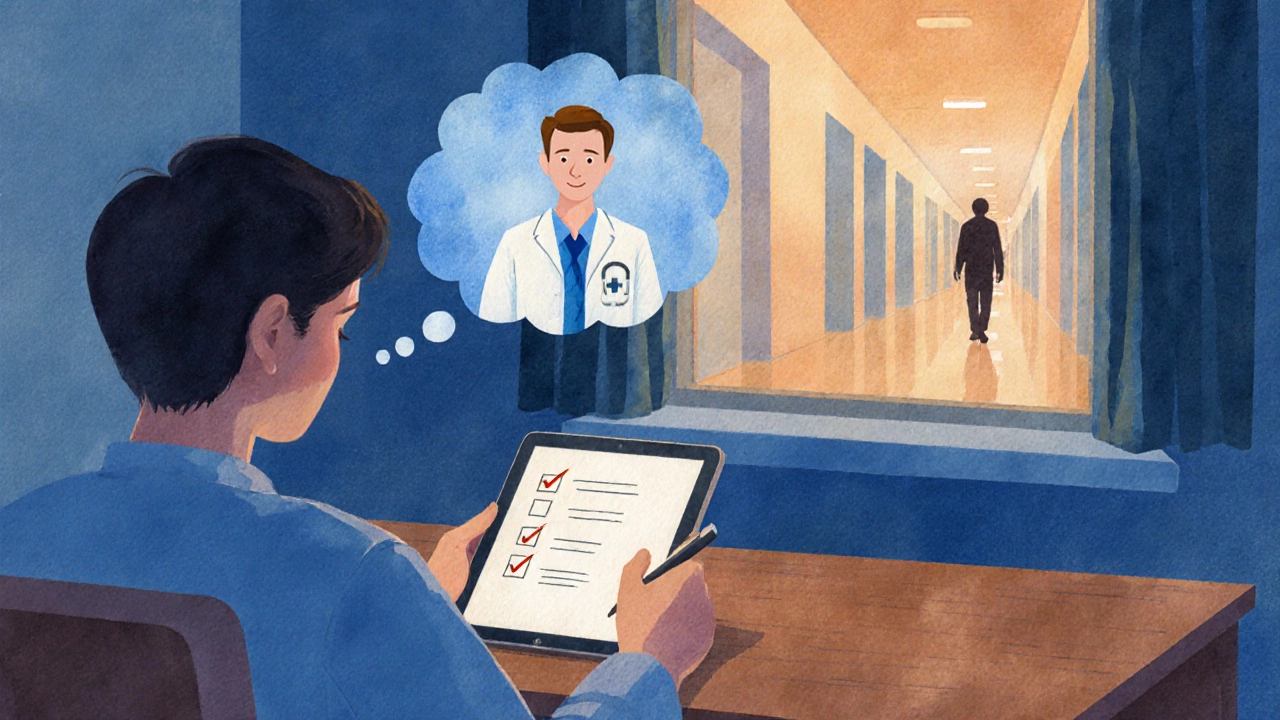Best Doctor for Bone Problems: How to Choose the Right Orthopedic Specialist
 Oct, 17 2025
Oct, 17 2025
Quick Takeaways
- Orthopedic surgeons handle most bone injuries, joint replacements, and complex fractures.
- Rheumatologists focus on inflammatory bone diseases like arthritis.
- Sports medicine doctors and physiotherapists are great for sports‑related injuries and rehab.
- Check credentials: board certification, years of experience, and patient reviews.
- Use the checklist at the end to narrow down the right doctor for your situation.
When a bone aches, cracks, or just feels off, the first thought is often “Which doctor should I see?” The answer isn’t one‑size‑fits‑all. Different specialists treat different bone problems, and picking the right one can shave weeks off recovery and save money. Below you’ll find a plain‑spoken guide that walks you through the main types of bone doctors, what they treat, and how to decide which one fits your needs.
What actually counts as a “bone doctor”?
In everyday talk, people use “bone doctor” to mean anyone who deals with the skeleton. Medically, the term covers several specialties:
- Orthopedic Surgeon is a surgeon who repairs bones, joints, ligaments, and tendons. They perform operations ranging from fixing a broken wrist to replacing a hip.
- Rheumatologist is a physician who treats inflammatory conditions that weaken bones, such as rheumatoid arthritis and lupus.
- Sports Medicine Doctor specializes in injuries that happen during athletic activities, often combining non‑surgical care with quick‑return‑to‑play protocols.
- Pediatric Orthopedic Surgeon focuses on bone and joint problems in children, from developmental dysplasia of the hip to growth‑plate fractures.
- Spine Surgeon (sometimes an orthopedic spine specialist) deals with vertebral fractures, disc herniations, and spinal deformities.
- Physiotherapist isn’t a doctor, but plays a crucial role in bone rehab, teaching exercises that boost healing and prevent re‑injury.
Each of these professionals brings a unique set of tools. Knowing which tool matches your problem is the first step toward a speedy fix.
When to see an Orthopedic Surgeon
If you’ve broken a bone, need a joint replaced, or have a chronic condition that isn’t improving with medication, an orthopedic surgeon is usually the go‑to. Here are the hallmark signs:
- Severe pain that doesn’t ease with over‑the‑counter meds.
- Visible deformity or a limb that looks out of place.
- Loss of function - you can’t bear weight, lift your arm, or move a joint.
- Imaging (X‑ray, CT, MRI) showing a fracture, severe arthritis, or tumor.
In Birmingham, many reputable hospitals run dedicated orthopedic units staffed by surgeons with British Orthopaedic Association (BOA) certification. Look for the BOA badge on the clinic’s website; it tells you the doctor follows national standards.
Rheumatologist vs. Orthopedic Surgeon - what’s the real difference?
Both treat bone‑related issues, but the focus differs. A rheumatologist dives deep into autoimmune and inflammatory diseases that erode bone over time. They prescribe disease‑modifying drugs, biologics, and lifestyle plans. Orthopedic surgeons, on the other hand, step in when the bone or joint has already suffered structural damage and often need a hands‑on procedure.
Typical rheumatology cases include:
- Rheumatoid arthritis causing joint erosion.
- Osteoporosis leading to frequent low‑impact fractures.
- Gout attacks that damage cartilage.
If you’ve been on medication for months and the pain persists, ask your GP for a referral to a rheumatologist first. If imaging shows a collapsed vertebra or a joint that’s too damaged, the rheumatologist will likely hand you over to an orthopedic surgeon.

Sports Medicine Doctors and Physiotherapists - the non‑surgical route
For athletes and active folks, the first line of defense is often a sports medicine doctor. They specialize in soft‑tissue injuries (ligaments, tendons) that affect bones indirectly. Their toolbox includes:
- Diagnostic ultrasound and MRI to pinpoint the injury.
- Injection therapy (corticosteroids, PRP) to reduce inflammation.
- Tailored rehab programs that a physiotherapist will oversee.
Physiotherapists design the exercises you’ll actually do at home or in the clinic. They’re essential after a fracture is set, after joint replacement surgery, or even for chronic low‑back pain that stems from poor bone alignment.
Special cases: children and the spine
Kids aren’t just small adults. Their bones are still growing, which means a fracture can affect future growth plates. A pediatric orthopedic surgeon knows how to fix these injuries while preserving growth potential. Conditions like slipped capital femoral epiphysis (SCFE) or congenital hip dysplasia are best handled by these specialists.
Spine issues, such as compressed vertebrae from osteoporosis or herniated discs, often require a spine surgeon. Some spine surgeons are orthopedists, others are neurosurgeons; the key is board certification in spine surgery and a track record of successful outcomes.
How to vet a bone specialist - a simple checklist
Choosing the right doctor feels like a job interview. Keep this list handy when you’re scrolling through hospital bios or talking to your GP:
- Board Certification: Look for BOA, Royal College of Surgeons (RCS) in orthopedics, or Royal College of Physicians for rheumatology.
- Experience: How many years have they performed the specific procedure you need? Ask for numbers - e.g., “I’ve done 150 total knee replacements in the last five years.”
- Sub‑specialty: Does the surgeon focus on upper‑limb trauma, hip arthroplasty, or spine? Pick one whose focus matches your problem.
- Hospital Affiliation: High‑volume hospitals tend to have better outcomes. In the UK, look for NHS Trusts or private hospitals with orthopedics accreditation.
- Patient Reviews: Read NHS patient surveys, Trust quality ratings, and independent review sites for real‑world feedback.
- Consultation Style: Do they explain the procedure in plain language? Do they answer questions without jargon? A good bedside manner reduces anxiety.
- Insurance / NHS Coverage: Ensure the doctor’s services are covered under your NHS plan or private insurance to avoid surprise bills.
Cross‑check each point before you book that first appointment. The extra effort now pays off in smoother recovery later.

Real‑world examples: how people chose the right doctor
Case 1 - 62‑year‑old with hip pain: Jane felt a grinding sensation when walking. An X‑ray showed advanced osteoarthritis. She first saw a rheumatologist, who tried injections and physiotherapy for three months. When pain persisted, her rheumatologist referred her to an orthopedic surgeon who performed a total hip replacement. Six months later, Jane walks without a cane.
Case 2 - 19‑year‑old soccer player with an ankle sprain: Tom twisted his ankle during a match. A sports medicine doctor ordered an MRI, confirming a high‑ankle ligament tear. Instead of immediate surgery, the doctor prescribed a brace and a physiotherapist‑guided rehab plan. Tom returned to play in 10 weeks, avoiding an operation.
Case 3 - 8‑year‑old with a wobbly knee: Lily’s parents noticed she limped after a playground fall. An X‑ray showed a growth‑plate fracture. A pediatric orthopedic surgeon aligned the bone and fitted a small brace. Regular follow‑ups ensured the knee grew normally, and Lily now runs marathons.
These stories illustrate that matching the doctor to the problem can spare you unnecessary tests, surgeries, and downtime.
Comparison of common bone specialists
| Specialty | Key Conditions Treated | Typical Procedures | When to See |
|---|---|---|---|
| Orthopedic Surgeon | Fractures, severe arthritis, joint degeneration, bone tumors | Open reduction internal fixation, joint replacement, arthroscopy | Structural damage visible on imaging, loss of function |
| Rheumatologist | Rheumatoid arthritis, osteoporosis, gout, lupus | Medication management, biologic therapy, joint aspiration | Chronic pain with inflammatory markers, progressive joint loss |
| Sports Medicine Doctor | Ligament sprains, tendonitis, stress fractures, meniscus tears | Injection therapy, bracing, minimally invasive surgery | Activity‑related injury, desire for quick return to sport |
| Pediatric Orthopedic Surgeon | Growth‑plate injuries, developmental dysplasia, scoliosis | Closed reduction, guided growth implants, spinal fusion | Bone issues in patients under 18, especially after trauma |
| Spine Surgeon | Vertebral fractures, disc herniation, spinal stenosis | Spinal fusion, laminectomy, vertebroplasty | Persistent back pain with neurological signs or imaging findings |
| Physiotherapist | Post‑operative rehab, chronic musculoskeletal pain | Therapeutic exercise, manual therapy, gait training | After surgery or injury to improve function and prevent re‑injury |
Next steps - how to book the right appointment
Now that you know which specialist fits your issue, here’s a quick action plan:
- Write down your main symptom, when it started, and any imaging you already have.
- Check the NHS website or your private insurer for a list of approved providers in Birmingham.
- Use the checklist above to narrow down 1‑2 doctors.
- Call the clinic’s appointment desk. Ask for a “new‑patient orthopaedic consultation” or the specific specialty you need.
- Prepare questions: “How many of these surgeries have you performed?” “What’s the typical recovery timeline?” “Will I need physiotherapy afterwards?”
- After the first visit, decide if you’re comfortable with the treatment plan. If not, you’re free to seek a second opinion.
Remember, the best doctor isn’t always the one with the flashiest website - it’s the one who matches your clinical need, talks clearly, and has a proven track record.
Frequently Asked Questions
Do I need a referral from my GP to see an orthopedic surgeon?
In the NHS system, a GP referral is usually required for specialist appointments, including orthopaedics. Private patients can often book directly, but many still prefer a referral to ensure the right specialist is chosen.
How can I tell if a doctor is board‑certified?
Look for the British Orthopaedic Association (BOA) logo or the Royal College of Physicians marking on the doctor’s profile. You can also verify certification on the General Medical Council (GMC) website.
What’s the typical recovery time after a total knee replacement?
Most patients start gentle physiotherapy within a day of surgery and can walk with a cane after 2‑3 weeks. Full recovery, meaning returning to normal activities, usually takes 3‑6 months.
Are there non‑surgical options for a slipped disc?
Yes. Physical therapy, core strengthening, epidural steroid injections, and activity modification often relieve symptoms. Surgery is reserved for persistent nerve compression or weakness.
What should I bring to my first specialist appointment?
Bring any imaging reports (X‑ray, MRI), a list of current medications, your medical history, and a notebook for questions. If you have insurance, have the policy details handy.
Choosing the right bone doctor may feel overwhelming, but breaking the process into clear steps makes it manageable. Use the checklist, ask the right questions, and trust your gut on communication style. With the right specialist, you’ll get back to the activities you love-whether that’s walking the Birmingham Canal, playing a weekend football match, or simply climbing a ladder without wincing.